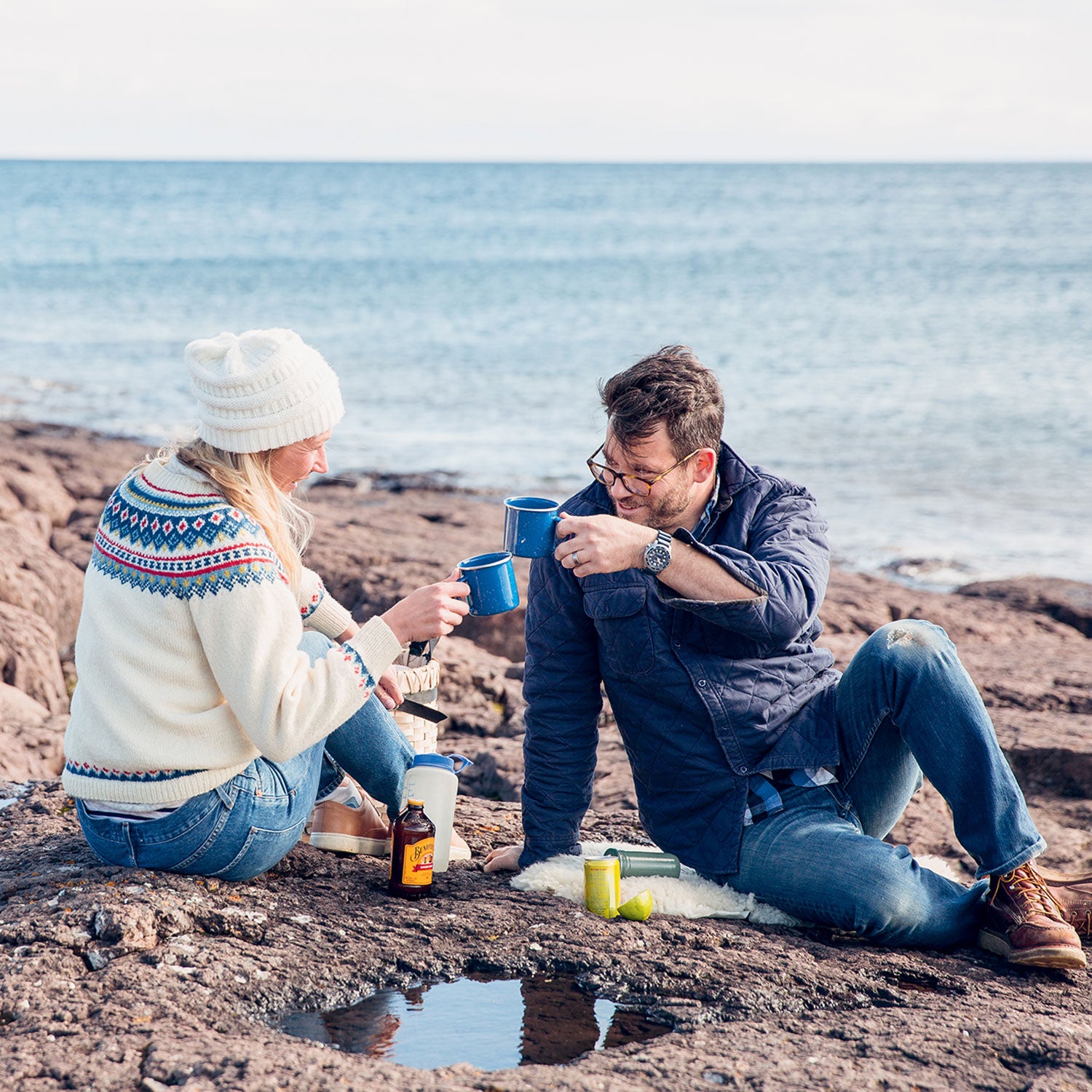Emily Vikre’s favorite spirit is Green Chartreuse, a distilled liquor she describes as “kind of weird and intense, but also sweet and complex, and…pretty much awesome.”
It’s not surprising that Vikre would choose a quirky, complicated libation made from 130 macerated botanicals as her “spirit spirit.” Her own life is one of layered complexity. The 38-year-old grew up in Duluth, Minnesota. Her Norwegian mother was a children’s book author and her physician father’s idea of fun was “three-day big-wall climbs fueled by carrots and soy nuts,” she says. Vikre spent her childhood summers swimming and picking berries at the family’s cottage in a North Sea fishing village in Norway.
She earned a PhD from Tufts University in food policy and behavioral theory before moving back to Duluth to cofound , a tasting room for handmade spirits, with her husband, Joel, in 2014. She’s the mother of two young sons, Espen and Vidar, and the author of two books: (2020, Harvard Common Press) and (2022, Harvard Common Press). Both books are a celebration of “wild abundance,” says Vikre. ���ϳԹ��� interviewed her to learn more about that philosophy, plus a few of her favorite recipes.
���ϳԹ���: Some people may say that combining cocktails and camping with kids is��a recipe for disaster. What’s your response?
Vikre: Abundance is a counterpoint to excess. I love having one good cocktail and that’s enough. You can totally be having fun with your family and be tired at the end of the day and be like, I’m going to have one really awesome cocktail while my kids are making s’mores.
Your books are a nice mixture of easy, roughing-it recipes and��impressively glamorous gourmet spreads and libations. Why are both extremes important in the same outdoor experience?
It’s nice to have that mix, to have maybe 75 percent of what you make be super simple, but then have one or two show-stopping meals that you put more effort into. On our next camping trip,��we’re going to do one fancy breakfast with Dutch Oven Sweet Rolls and one fancy dinner with Grilled Kebab Fajitas, and everything else is going to be really easy.
How do your Norwegian roots inform your life and your work?
In Norway, whatever you do, you’re doing things outside. It’s just part of your day, part of how you live, part of how you have fun. Mountain hikes are packed with people who have two-year-olds, six-year-olds, and eight-year-olds, and at the top of the mountain there’s a hut where someone is making waffles and selling chocolate and this lifestyle is just part of your identity, part of how you exist.
There’s a strong foraging element, especially in your cocktail book. How did that come about?
It’s a Norwegian thing. I was brought up picking. When it’s berry season you can barely make it fives steps at a time because you have to stop and pick blueberries, raspberries, strawberries, spruce pine tips, and wood sorrel,��or whatever is in season. Snacking on them, I felt a sense of being provided for during certain months of the year.
What’s your most practical advice on how to manage the entire family’s appetites on a camping trip?
I always pack lots of trail chocolate and fruit for when we are skiing, hiking, portaging—anything that is a true “we have to get from A to B” activity. Then we have regular little breaks to have a piece of chocolate and we set a goal for how far we are going to make it before our next one, like, “now let’s to make it to the next blue trail marker and we’ll have another chocolate stop!” For even longer outings I also pack up bread and cheese and salami— basically the Norwegian matpakke from the book— so we can stop for picnic moments.
I definitely recommend engaging kids in planning what meals you will have in camp so they are excited about them. And personally, I have no problem with serving my kids a meal they aren’t particularly enthusiastic about if they and I both know that the next meal is one they chose. I remind them sometimes you get to be the chooser and sometimes someone else does. But if you’re making mac and��cheese, definitely make sure you have their favorite brand or recipe. My older son will never let us forget the time we went camping and brought a type of mac and��cheese he didn’t like.
What’s your go-to recipe in your new book?
The chilaquiles for breakfast, because it seems like a fancy recipe but it’s really a five-minute recipe where you’re cooking chips and salsa that you brought and adding an egg. It’s a real pro move. (Recipe below)
What’s a good alternative to a ��’m�ǰ���?
The Norwegian Stick Bread is a fun campfire activity that not too many people in this country know about, but it’s classic in Norway. (Recipe below)
And now for the cocktail. Of the many you have invented or refined, which one do you recommend?
The Shetland Sweater is a very complicated, very balanced cocktail. But you can do all the work at home, then stick it in a flask or a water bottle, so you have it for nipping from in the evening. (Recipe below)
Chilaquiles
Serves four
Ingredients
- 2 cups store-bought salsa (tomato or tomatillo, depending on if you prefer chilaquiles rojos or verdes), at whatever level of spiciness your family likes
- ¼ cup water
- 8 cups tortilla chips
- 1 tablespoon butter
- 4 eggs
- Salt
- Avocado slices, queso fresco, and cilantro for serving (optional)
Instructions
In a large skillet over medium-high heat, bring the salsa to a simmer. Stir in the water to loosen the salsa, then simmer for about two minutes. Add the tortilla chips and stir well to coat, then cook until the chips are warmed through, two to three minutes. Transfer the chilaquiles to plates.
Return the pan to the heat and add the butter. When the butter has melted and foamed, crack in the eggs. Sprinkle with salt. Fry the eggs to your desired level of doneness, then slide an egg onto each plate of chilaquiles. Add avocado, queso fresco, and cilantro (or other toppings) as desired.
Norwegian Stick Bread (Pinnebrød) with Garlic Butter
Makes about a dozen bread twists
Ingredients
For the Bread Dough��
- 3 1/3 cups flour
- 1 teaspoon salt
- 1 tablespoon sugar
- 1 tablespoon baking powder
- ½ cup plus 2 tablespoons oil (I just use olive oil, as I do for most things that call for oil)
- 1 ¼ cup water
For the Garlic Butter
- ½ cup butter
- 4 garlic cloves, minced
Instructions
At-Home Prep: Combine all the dry ingredients for the bread in a large bowl and make a well in the center. In another container, whisk together the oil and water to emulsify them, then drizzle into the well of the dry ingredients. Mix everything together with a wooden spoon until a shaggy ball forms. Get in there with your hands and knead the dough 8 to 10 times, bringing it together into a smooth dough ball. Coat the dough ball with some additional oil, then transfer it to a zip-top bag or sealed container to transport.
In��Camp: In a small pot, heat the butter until it is melted. Stir in the minced garlic and cook for a minute until it has softened. (I do this because I love cooked garlic. You can also just melt the butter and stir in the garlic off the heat.) Break off pieces of dough that are about the size of a walnut, roll them into thin ropes and twist them around cooking sticks. (Use sturdy, green tree branches like the kind you would use for hot dogs. Make sure they are sturdy enough to hold a breadstick. Brush the outside of the bread twist with a bit of garlic butter, then cook over fire embers, turning often until the bread is browned on the outside and cooked through to the middle. Repeat to make as many bread twists as you want. Brush with more garlic butter and eat warm. Leftover dough can be cooked as flatbread in a skillet.
The Shetland Sweater
For a 32-ounce water bottle��
Ingredients
- 10 ½ ounces blended Scotch
- 5 ¼ ounces Laird’s bonded applejack
- 5 ¼ ounces Averna amaro
- 5 ¼ ounces Amaro Nonino
- ¾ ounce maple syrup
- 6 dashes orange bitter
- 5 ¼ ounces water
Instructions
Combine all ingredients, stir gently to combine, and pour or funnel all that fits into your carrying vessel.


